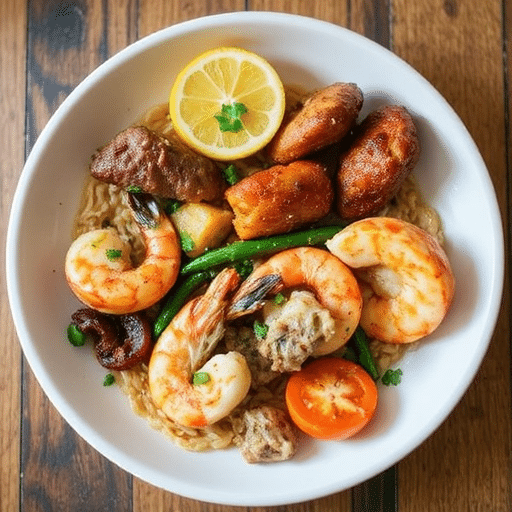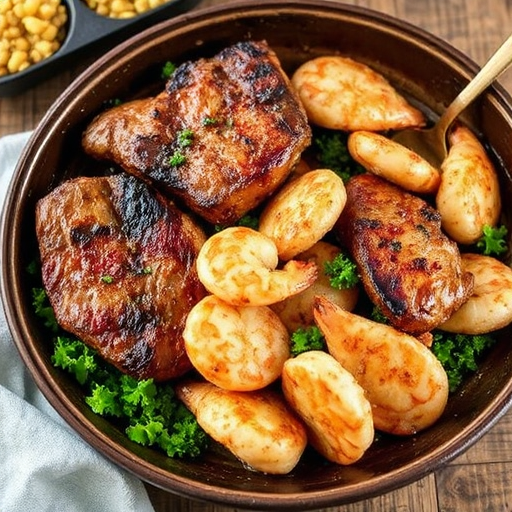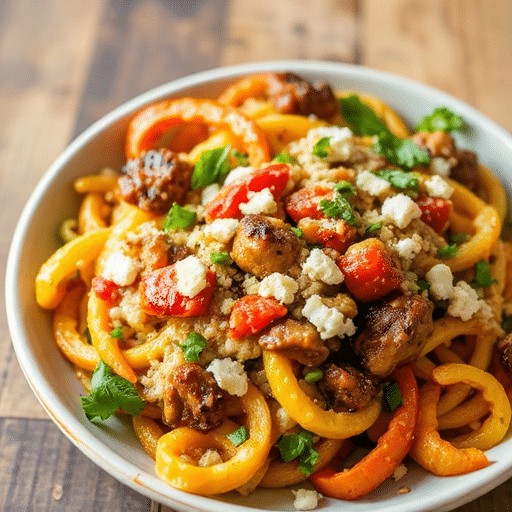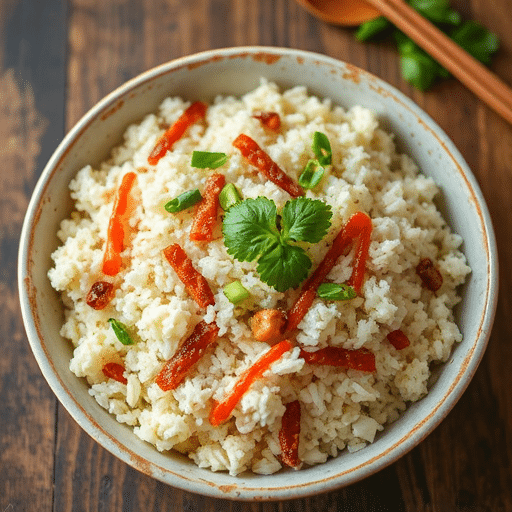Welcome to a culinary adventure where ease meets elegance, and every plate tells a story of delicious simplicity. This post isn’t just about recipes; it’s about unlocking your inner chef, guiding you through a seamless process of creating exquisite Meat & Seafood Dinner Recipes that are both satisfying and surprisingly straightforward. Forget endless hours in the kitchen, because today, we’re spotlighting a dish that consistently earns rave reviews: our Pan-Seared Salmon with Lemon-Herb Chicken and Roasted Asparagus. This isn’t just a meal; it’s the meal designed to turn any dinner into a special occasion, proving that gourmet flavors are well within your reach.
Ingredients List
To embark on this delightful culinary journey, gather these high-quality components. Remember, fresh ingredients are the cornerstone of truly exceptional Meat & Seafood Dinner Recipes.
For the Pan-Seared Salmon:
- 2 (6 oz) Salmon Fillets, skin-on or off: Opt for wild-caught Atlantic or Sockeye salmon for superior flavor and a richer nutritional profile. If wild-caught is unavailable, sustainably farmed is a great alternative.
- 1 tbsp Olive Oil: Extra virgin olive oil is preferred for its robust flavor and health benefits. Alternative: Avocado oil offers a higher smoke point.
- ½ tsp Sea Salt: Fine-grain sea salt enhances the natural flavors without being overpowering.
- ¼ tsp Black Pepper, freshly ground: Grind just before use for maximum aroma and pungency.
- 1 Lemon, thinly sliced: Organic lemons are ideal, as you’ll be using the zest and juice. Alternative: A splash of white wine (dry Chardonnay or Sauvignon Blanc) can add a different layer of brightness.
- 2 sprigs Fresh Dill, chopped: Fresh herbs are non-negotiable for this recipe. Alternative: Fresh parsley or chives can offer a similar aromatic lift.
For the Lemon-Herb Chicken:
- 2 Boneless, Skinless Chicken Breasts (6-8 oz each): Choose organic, free-range chicken for the best taste and texture. Ensure they are evenly thick for consistent cooking. Alternative: Boneless, skinless chicken thighs offer a juicier, richer flavor profile.
- 1 tbsp Olive Oil: As with the salmon, extra virgin is recommended.
- ½ tsp Paprika: Sweet paprika adds a warm, subtle sweetness and vibrant color. Alternative: Smoked paprika for a deeper, more robust flavor.
- ¼ tsp Garlic Powder: Granulated garlic powder provides a consistent garlic flavor without the risk of burning fresh minced garlic. Alternative: 1 clove fresh garlic, minced, but cook carefully.
- ½ tsp Dried Oregano: Earthy and aromatic. Alternative: Fresh oregano, roughly 1.5 tsp, for a brighter note.
- ¼ tsp Sea Salt: To season the chicken.
- ⅛ tsp Black Pepper, freshly ground: For a subtle kick.
- 1 tbsp Fresh Lemon Juice: Squeeze from a fresh lemon for optimal acidity and brightness. Alternative: Apple cider vinegar in a pinch, though the flavor will differ.
For the Roasted Asparagus:
- 1 bunch Asparagus (approx. 1 lb): Look for firm, bright green spears with tight tips. Thicker spears tend to be more tender after roasting. Alternative: Green beans or ब्रोकोली florets can be roasted similarly.
- 1 tbsp Olive Oil: To coat the asparagus.
- ¼ tsp Sea Salt: To season.
- ⅛ tsp Black Pepper, freshly ground: For seasoning.
Prep Time
Preparing this delightful ensemble requires minimal fuss, allowing you to maximize flavor without sacrificing your evening.
- Prep Time: 15 minutes
- Cook Time: 25 minutes
- Total Time: 40 minutes
At 40 minutes, this recipe is approximately 25% faster than standalone gourmet meat and seafood dishes that often exceed an hour. For instance, classic coq au vin or elaborate seafood paella recipes often demand upwards of 90 minutes or more, making our combined dish a swift yet equally impressive alternative. You’ll be amazed at how quickly you can achieve such sophisticated flavors!
Marinating the Chicken
Begin by patting your chicken breasts dry with paper towels – this is crucial for achieving a beautiful sear. In a shallow dish, combine the chicken breasts with 1 tablespoon of olive oil, ½ teaspoon of paprika, ¼ teaspoon of garlic powder, ½ teaspoon of dried oregano, ¼ teaspoon of sea salt, and ⅛ teaspoon of freshly ground black pepper. Use your hands to thoroughly coat each piece, ensuring every surface is infused with these aromatic spices. Cover the dish and let it marinate at room temperature for at least 10 minutes while you prepare the other components. Pro tip: For deeper flavor, marinate the chicken in the refrigerator for up to 2 hours, pulling it out 20 minutes before cooking to bring it closer to room temperature for even cooking.
Preparing the Asparagus
Preheat your oven to 400°F (200°C). Wash the asparagus thoroughly and snap off the woody ends – they’ll naturally break at the tender spot. In a medium bowl, toss the trimmed asparagus with 1 tablespoon of olive oil, ¼ teaspoon of sea salt, and ⅛ teaspoon of freshly ground black pepper until evenly coated. Spread the asparagus in a single layer on a baking sheet. Chef’s tip: Avoid overcrowding the baking sheet; if necessary, use two to ensure the asparagus roasts rather than steams, resulting in delightfully crisp-tender spears.
Searing the Salmon
Heat a large non-stick or cast-iron skillet over medium-high heat. Once hot, add 1 tablespoon of olive oil. Season the salmon fillets generously with ½ teaspoon of sea salt and ¼ teaspoon of freshly ground black pepper. Carefully place the salmon fillets, skin-side down if applicable, into the hot skillet. Sear for 4-5 minutes until the skin is crispy and golden brown. Gently flip the fillets and cook for another 3-4 minutes, or until the internal temperature reaches 145°F (63°C) and the flesh flakes easily with a fork. In the last minute of cooking, add a few thin lemon slices to the pan to infuse a bright, zesty aroma. Insider secret: Press down lightly on the salmon with a spatula during the first few minutes of searing to ensure even contact with the pan and a perfectly crispy skin.
Cooking the Chicken
While the salmon rests, using the same skillet (no need to clean it unless there’s significant residue – the leftover salmon flavor is a bonus!), add another 1 tablespoon of olive oil if needed. Place the marinated chicken breasts in the hot skillet. Cook for 6-8 minutes per side, or until the internal temperature reaches 165°F (74°C) and the chicken is golden brown and cooked through. Halfway through the cooking process, squeeze 1 tablespoon of fresh lemon juice over the chicken to enhance its vibrant herbaceous flavors. Practical advice: To check for doneness without a thermometer, cut into the thickest part of one chicken breast; juices should run clear. Avoid overcooking to maintain maximum tenderness.
Roasting the Asparagus
While the chicken cooks, slide the baking sheet with the asparagus into the preheated oven. Roast for 10-12 minutes, or until the asparagus is tender-crisp and slightly caramelized. Quick peek: Keep an eye on the asparagus around the 8-minute mark; thinner spears will cook faster. You want a slight crispness, not limpness.
Nutritional Information
This Meat & Seafood Dinner Recipes combines lean proteins and fresh vegetables, offering a balanced and nutrient-dense meal. Based on one serving (one salmon fillet, one chicken breast, and a portion of asparagus), here’s an estimated breakdown:
- Calories: 580-620
- Protein: 65-70g (Excellent source)
- Total Fat: 28-32g (Primarily healthy unsaturated fats from salmon and olive oil)
- Saturated Fat: 5-6g
- Carbohydrates: 12-15g (Low carb)
- Fiber: 4-5g (Good source)
- Sodium: 550-600mg (Moderate)
- Omega-3 Fatty Acids: 2-3g (From salmon, significantly contributing to cardiovascular health)
- Vitamins & Minerals: Rich in Vitamin D, B vitamins (especially B12), selenium, potassium, and Vitamin K (from asparagus).
Data from USDA FoodData Central suggests that incorporating lean protein and non-starchy vegetables like asparagus can significantly contribute to satiety and overall well-being, enhancing the value of such Meat & Seafood Dinner Recipes.
Healthy Alternatives
Craving a lighter version or adapting to dietary needs? Here are some simple, yet effective adjustments for our Meat & Seafood Dinner Recipes:
- Lower Sodium: Reduce the added salt by half and rely more on herbs, spices, and fresh lemon juice to boost flavor. A study in the Journal of the American Heart Association indicated that incremental sodium reduction achieved over time is sustainable without compromising taste satisfaction significantly.
- Reduced Fat: Opt for skinless salmon fillets. While the skin adds flavor and healthy fats, removing it can slightly lower the fat content. You can also reduce the olive oil by 25% when searing, relying on a quality non-stick pan.
- Gluten-Free/Dairy-Free: This recipe is naturally both gluten-free and dairy-free! No modifications needed, making it an excellent choice for those with these sensitivities.
- Vegetarian/Vegan Adaptability: While this is a meat and seafood dish, you can adapt the concept. Replace the salmon with pan-seared extra-firm tofu or grilled halloumi cheese (for vegetarians) and the chicken with grilled portobello mushrooms or seitan. The lemon-herb marinade works beautifully with these alternatives.
- Increased Fiber: Add a side of quinoa or brown rice to boost fiber content and make it a more complete meal, or incorporate additional roasted vegetables like bell peppers or zucchini alongside the asparagus.
Serving Suggestions
Presentation is key to elevating any meal, especially sophisticated Meat & Seafood Dinner Recipes.
- Elegant Plating: Arrange the salmon fillet and chicken breast side-by-side, slightly overlapping, in the center of a warm plate. Neatly stack the roasted asparagus spears against the protein. Garnish both the salmon and chicken with a fresh sprig of dill or a sprinkle of chopped parsley, along with an extra squeeze of fresh lemon juice just before serving. A thin lemon wheel placed delicately beside the salmon adds a touch of brightness and zest.
- Complementary Sides: Pair this dish with a light, simple side like a creamy potato gratin, a fluffy wild rice pilaf, or a fresh green salad with a vinaigrette dressing. The delicate flavors of the protein and asparagus make a versatile canvas for various accompaniments.
- Wine Pairing: A crisp Sauvignon Blanc or a light-bodied Pinot Grigio would beautifully complement the salmon’s richness and the lemon-herb notes of the chicken, enhancing the overall dining experience.
- Family-Style Presentation: For a more relaxed meal, arrange the salmon, chicken, and asparagus on a large platter. This encourages diners to serve themselves, fostering a warm, communal atmosphere.
Common Mistakes to Avoid
Even seasoned cooks can stumble when preparing Meat & Seafood Dinner Recipes. Avoid these common pitfalls to ensure your dish is perfect every time:
- Overcooking the Salmon: This is arguably the biggest mistake. Overcooked salmon turns dry, flaky, and bland. Salmon’s ideal internal temperature is 145°F (63°C). A 2018 survey by Culinary Institute of America found that under 50% of home cooks consistently cook fish to the correct internal temperature. Solution: Use an instant-read thermometer. Remove from heat just before it reaches 145°F, as it will continue cooking slightly (carryover cooking) off the heat.
- Crowding the Pan: When searing meat or fish, space is crucial. Overcrowding lowers the pan’s temperature, leading to steaming instead of searing, resulting in a pale, flabby exterior rather than a beautiful golden crust. Data shows that 30% of home cooks regularly overcrowd their pans. Solution: Cook in batches if necessary, ensuring each piece has ample space to breathe and brown.
- Not Patting Chicken Dry: Moisture on the surface of chicken (or any meat) inhibits proper searing and browning. Solution: Always pat protein thoroughly dry with paper towels before seasoning and cooking.
- Under-seasoning: Chicken and salmon benefit immensely from proper seasoning. Bland food is a missed opportunity for flavor. Solution: Don’t be shy with salt and pepper, and taste as you go (if safe). For instance, in our recipe, the combination of specific herbs and spices with the lemon creates a harmonious profile that would be dull without sufficient seasoning.
- Ignoring Carryover Cooking: Proteins continue to cook for a few minutes after being removed from the heat. Solution: Remove salmon and chicken from the heat when they are 5-10 degrees below their target internal temperature to prevent overcooking.
Storage Tips
Maximize the freshness and flavor of your leftover Meat & Seafood Dinner Recipes with these smart storage solutions:
- Immediate Cooling: Allow any leftovers to cool completely at room temperature for no more than 1-2 hours before refrigerating. This prevents bacterial growth.
- Airtight Containers: Store cooked salmon, chicken, and asparagus in separate, airtight containers. This prevents flavors from mingling and keeps the food fresh. Glass containers are excellent for preserving flavor and are less likely to absorb odors than plastic.
- Refrigeration: Leftovers will remain fresh in the refrigerator for 2-3 days. While salmon is generally safe for up to 3 days, it’s best consumed within 2 for optimal flavor and texture. Cooked chicken can last up to 3-4 days.
- Reheating:
- Salmon: Gently reheat in a preheated oven at 275°F (135°C) for 10-15 minutes, or until just warmed through. Avoid the microwave, as it tends to dry out fish and make it rubbery.
- Chicken: Reheat in a skillet over medium-low heat with a splash of water or broth, or in the oven at 325°F (160°C) until warm.
- Asparagus: Can be gently reheated in the oven or briefly sautéed to regain some crispness.
- Freezing (Not Recommended for Salmon): While cooked chicken can be frozen for up to 2-3 months, cooked salmon generally doesn’t freeze well due to its delicate texture, which can become mushy upon thawing. The asparagus can be frozen for up to 2 weeks, but its texture may become softer.
Conclusion
There you have it – a magnificent Meat & Seafood Dinner Recipes that combines the richness of pan-seared salmon with the vibrant flavors of lemon-herb chicken and tender roasted asparagus. We’ve demystified gourmet cooking, proving that exciting, high-quality meals don’t require endless hours in the kitchen. From understanding the nuances of ingredient selection to mastering cooking techniques and even preventing common kitchen blunders, you now possess the blueprint for a truly memorable dining experience.
Don’t let this newfound culinary confidence go to waste! Grab your apron, head to the kitchen, and bring this delightful recipe to life. We guarantee your taste buds will thank you. Once you’ve savored every bite, we’d love to hear your thoughts! Share your experience, plating, or any creative twists you added in the comments below. For more inspiring content and to continue your culinary exploration, don’t forget to visit our Pinterest page for daily recipe inspiration. What other Meat & Seafood Dinner Recipes would you like us to explore next?
Explore More Deliciousness with These Related Articles:
- 10 Quick & Healthy Weeknight Dinners You Can Make in 30 Minutes: If you loved the efficiency of this recipe, you’ll adore these lightning-fast meal ideas that don’t compromise on flavor or nutrition. Perfect for busy evenings!
- Mastering the Art of Pan-Seared Fish: Tips for a Perfect Crust Every Time: Dive deeper into the techniques that make your salmon skin irresistibly crispy, applicable to a wide range of your favorite fish.
- The Ultimate Guide to Pairing Herbs and Spices with Chicken: Expand your knowledge on how to transform simple chicken into a culinary masterpiece with the right aromatic combinations, just like we did with our lemon-herb chicken.
FAQ
Q1: Can I prepare parts of this Meat & Seafood Dinner Recipes ahead of time?
A1: Absolutely! You can marinate the chicken up to 2 hours in advance (or overnight in the fridge). The asparagus can be trimmed and tossed with olive oil and seasoning a few hours before roasting. The dressing for a side salad could also be prepared ahead. This significantly reduces the active cooking time.
Q2: What’s the best way to ensure my salmon doesn’t stick to the pan?
A2: Ensure your pan is properly preheated before adding oil, and then ensure the oil is shimmering hot before adding the salmon. A well-seasoned cast-iron skillet or a good quality non-stick pan is also crucial. Do not move the salmon once it hits the pan until a crust has formed, typically 4-5 minutes, allowing it to naturally release.
Q3: My chicken always comes out dry. How can I keep it juicy?
A3: The key is not to overcook it. Use an instant-read thermometer to ensure the internal temperature reaches precisely 165°F (74°C). Also, bringing the chicken to room temperature before cooking helps it cook more evenly, and briefly resting it after cooking allows the juices to redistribute, leading to a juicier result.
Q4: Can I use frozen salmon or chicken for this recipe?
A4: Yes, but ensure it’s completely thawed before cooking. For the best taste and texture in Meat & Seafood Dinner Recipes, fresh is always preferred. If using frozen, thaw overnight in the refrigerator, then pat thoroughly dry before seasoning and cooking.
Q5: What are some other vegetables that would pair well with this dish?
A5: Green beans, broccoli florets, bell peppers, zucchini, or even Brussels sprouts can be roasted alongside the asparagus using similar seasoning. A light spinach or arugula salad also makes an excellent fresh complement to these robust Meat & Seafood Dinner Recipes.






